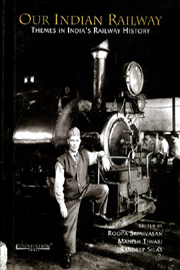Book contents
- Frontmatter
- Contents
- Foreword
- Preface
- Introduction
- 1 The Colonial Context of the Bengal Renaissance: A Note on Early Railway–Thinking in Bengal
- 2 Minute by Dalhousie on Introduction of Railways in India, as Submitted to the Court of Directors, 4 July 1850
- 3 Ackworth Committee Report
- 4 Competition and Adaptation: The Operation of Railways in Northern India: Uttar Pradesh 1860–1914
- 5 Economic Nationalism and the Railway Debate, circa 1880-1905
- 6 Railway Policing and Security in Colonial India, c. 1860–1930
- 7 Indian Nationalism and Railways
- 8 The Railway in Colonial India: Between Ideas and Impacts
- 9 The Dark Side of the Force: Mistakes, Mismanagement and the Malfeasance in Early Railways of the British Indian Empire
- 10 Tunnels and Bridges: Railways, Narrative and Power in two Novels of India
- 11 A View of the History of Indian Railways
- 12 The Romance of Steam
- Index
- Plate section
11 - A View of the History of Indian Railways
Published online by Cambridge University Press: 26 October 2011
- Frontmatter
- Contents
- Foreword
- Preface
- Introduction
- 1 The Colonial Context of the Bengal Renaissance: A Note on Early Railway–Thinking in Bengal
- 2 Minute by Dalhousie on Introduction of Railways in India, as Submitted to the Court of Directors, 4 July 1850
- 3 Ackworth Committee Report
- 4 Competition and Adaptation: The Operation of Railways in Northern India: Uttar Pradesh 1860–1914
- 5 Economic Nationalism and the Railway Debate, circa 1880-1905
- 6 Railway Policing and Security in Colonial India, c. 1860–1930
- 7 Indian Nationalism and Railways
- 8 The Railway in Colonial India: Between Ideas and Impacts
- 9 The Dark Side of the Force: Mistakes, Mismanagement and the Malfeasance in Early Railways of the British Indian Empire
- 10 Tunnels and Bridges: Railways, Narrative and Power in two Novels of India
- 11 A View of the History of Indian Railways
- 12 The Romance of Steam
- Index
- Plate section
Summary
Every winter when I was a child in Calcutta we went for a family holiday to the east coast temple town of Puri. That meant an overnight journey on the BNR, the Bengal Nagpur Railway and we remained in the railway hands when we got to Puri the next morning, staying at the old fashioned BNR hotel. As we entered Howrah on the way back my father would ask us to tell him what the initials on the goods wagons in the marshalling yard stood for. Of course we knew BNR but then there was BB and CI, Bombay Baroda and Central India, EIR, East India Railway, and many others. The one which always caught my fancy was the GIP, the Great Indian Peninsular. I did not know where it ran but it conjured up pictures of trains travelling great distances to remote and exciting places. In those days, the late thirties and early forties, trains were still the only way of travelling long distances in India, or indeed anywhere else. Air travel was in its infancy and cars were all right for getting around Calcutta but not much else. So the romance of railways was very real and I fell head over heels in love with them. I loved the mighty titans of the track, the incomparably beautiful steam engines, I loved the meals in restaurant cars, the gentle rocking to sleep at night, the excitement of timing the speed by the mile posts and the thrill when a mile was passed in a minute, the hustle and bustle of Howrah station, and the announcers reeling off lists of stations I had never heard of.
- Type
- Chapter
- Information
- Our Indian RailwayThemes in India's Railway History, pp. 230 - 241Publisher: Foundation BooksPrint publication year: 2006
- 1
- Cited by

